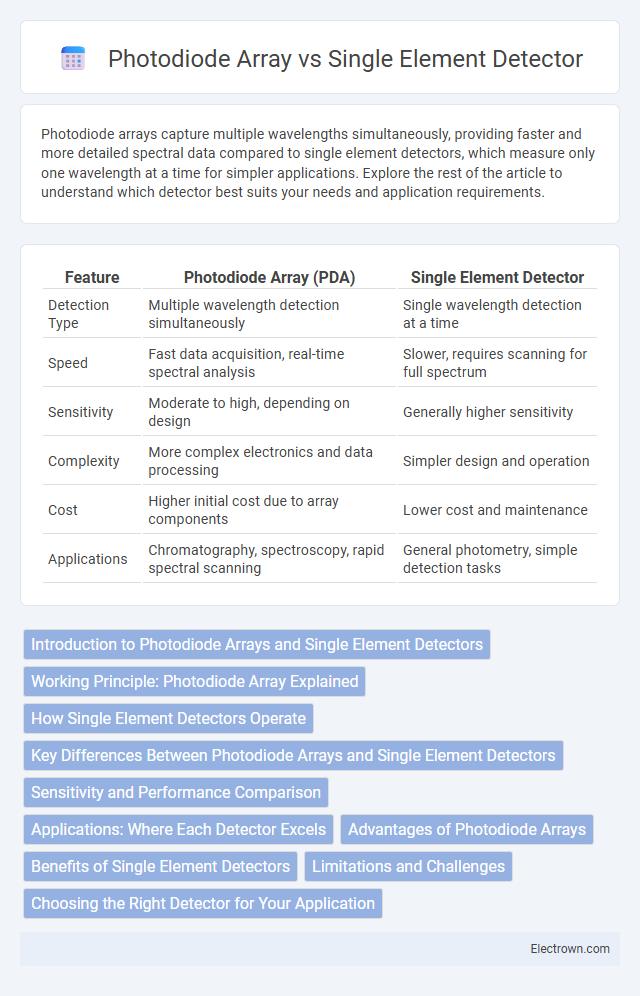Photodiode arrays capture multiple wavelengths simultaneously, providing faster and more detailed spectral data compared to single element detectors, which measure only one wavelength at a time for simpler applications. Explore the rest of the article to understand which detector best suits your needs and application requirements.
Table of Comparison
| Feature | Photodiode Array (PDA) | Single Element Detector |
|---|---|---|
| Detection Type | Multiple wavelength detection simultaneously | Single wavelength detection at a time |
| Speed | Fast data acquisition, real-time spectral analysis | Slower, requires scanning for full spectrum |
| Sensitivity | Moderate to high, depending on design | Generally higher sensitivity |
| Complexity | More complex electronics and data processing | Simpler design and operation |
| Cost | Higher initial cost due to array components | Lower cost and maintenance |
| Applications | Chromatography, spectroscopy, rapid spectral scanning | General photometry, simple detection tasks |
Introduction to Photodiode Arrays and Single Element Detectors
Photodiode arrays consist of multiple photodiodes arranged in a linear or two-dimensional configuration, allowing simultaneous detection of light across a range of wavelengths, which enables rapid spectral analysis in applications like chromatography and spectroscopy. Single element detectors contain one photodiode that measures light intensity at a specific wavelength or location, providing high sensitivity and accuracy for targeted measurements. Photodiode arrays offer faster data acquisition with spatial or spectral resolution, while single element detectors excel in simplicity, signal-to-noise ratio, and precise detection at single points.
Working Principle: Photodiode Array Explained
Photodiode arrays consist of multiple photodiodes aligned in a linear or two-dimensional configuration, allowing simultaneous detection of a range of wavelengths or spatial locations. Each photodiode in the array converts incident light into an electrical signal through the photoelectric effect, enabling rapid spectral or imaging analysis. Understanding the working principle of a photodiode array helps you maximize detection efficiency and resolution compared to single element detectors.
How Single Element Detectors Operate
Single element detectors operate by converting incident light into an electrical signal through a single photosensitive area, allowing precise measurement of light intensity at a specific wavelength or position. These detectors typically rely on materials such as silicon or germanium to generate a photocurrent proportional to the light intensity, making them suitable for applications requiring high sensitivity and low noise. Unlike photodiode arrays that capture multiple wavelengths simultaneously, single element detectors scan sequentially, offering superior signal-to-noise ratio for discrete spectral measurements.
Key Differences Between Photodiode Arrays and Single Element Detectors
Photodiode arrays consist of multiple photodiode sensors aligned in a linear or two-dimensional array, enabling simultaneous detection of light intensity across various wavelengths or positions, which significantly enhances spectral analysis and imaging speed. Single element detectors contain only one photodiode sensor, resulting in slower data acquisition as they scan wavelengths or positions sequentially, but they typically offer higher sensitivity and lower noise for single-point measurements. The choice between photodiode arrays and single element detectors depends on application requirements, with arrays favored for rapid, multi-wavelength detection and single element detectors preferred for precise, low-light intensity measurements.
Sensitivity and Performance Comparison
Photodiode arrays offer higher sensitivity and faster performance for detecting multiple wavelengths simultaneously due to their multiple photodiode elements, enhancing spectral resolution and throughput. Single element detectors provide superior sensitivity for single-wavelength detection with lower noise levels and better signal-to-noise ratio in targeted applications. The choice between photodiode arrays and single element detectors depends on whether multi-wavelength analysis or peak sensitivity at a specific wavelength is prioritized.
Applications: Where Each Detector Excels
Photodiode Array detectors excel in applications requiring fast, simultaneous multi-wavelength detection, such as in high-throughput chromatographic analysis and real-time spectral monitoring. Single Element Detectors are ideal for simpler, low-cost setups where high sensitivity at a specific wavelength is necessary, commonly used in targeted spectroscopy and environmental monitoring. Your choice depends on whether speed and spectral range or cost-effectiveness and sensitivity are the primary priorities.
Advantages of Photodiode Arrays
Photodiode arrays offer superior spectral resolution and faster data acquisition compared to single element detectors, enabling more precise and efficient analysis. These arrays capture multiple wavelengths simultaneously, enhancing the detection of complex sample compositions in real time. Your workflows benefit from improved sensitivity and the ability to perform multi-wavelength measurements without mechanical scanning.
Benefits of Single Element Detectors
Single element detectors offer high sensitivity and low noise performance, making them ideal for applications requiring precise light measurement. Their simple design ensures faster response times and easier integration into compact optical systems. These detectors excel in cost-effectiveness and reliability for single-wavelength or low-complexity detection tasks.
Limitations and Challenges
Photodiode arrays face limitations such as lower sensitivity and higher noise compared to single element detectors, which can affect signal accuracy in low-light conditions. Single element detectors often excel in applications requiring high sensitivity and fast response times but lack the ability to simultaneously capture spectral data across multiple wavelengths. Challenges with photodiode arrays include complex calibration and potential cross-talk between elements, while single element detectors demand sequential scanning, increasing measurement time and reducing real-time analysis capability.
Choosing the Right Detector for Your Application
Photodiode arrays offer simultaneous multi-wavelength detection, making them ideal for applications requiring rapid spectral analysis and high throughput, such as chromatography and spectroscopy. Single element detectors provide higher sensitivity and better signal-to-noise ratios, suitable for applications demanding precise measurements of single-wavelength signals or low light conditions. Choosing the right detector depends on balancing spectral resolution, speed, and sensitivity requirements specific to your analytical or imaging needs.
Photodiode Array vs Single Element Detector Infographic

 electrown.com
electrown.com